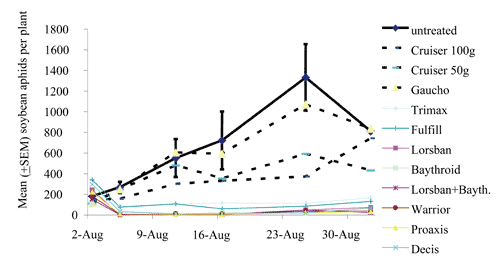Insecticide evaluations for soybean aphid management
|
During the 2005 growing season, the soybean entomology laboratory at Iowa State University evaluated several insecticides for efficacy against soybean aphids. Since the arrival of the soybean aphid to North America in 2000, the number of insecticides labeled for use against this pest has increased and continued to increase in 2005. Managing soybean aphids effectively requires consideration of the immediate ability of the product to kill aphids and then the length of residual activity. Residual activity is especially critical for products like seed treatments that must have an ability to kill aphids several months after planting. We reported data from our insecticide efficacy trials in the August 22, 2005, edition of the ICM Newsletter (see 2005 Preliminary insecticide evaluations, IC-494 [22]). In this article, we present the final data, including yield. To conduct a fair and balanced evaluation of insecticides of different classes (organophosphates, pyrethroids, nicotinoids) and application methods (seed treatments vs. foliar applications), we monitored soybean aphid populations at multiple times during the growing season. Since foliar insecticides were applied when aphid populations reached 250 per plant, our recommendation for soybean aphid management, we monitored populations throughout the growing season. In 2005, we applied insecticides on August 2. We monitored populations 3 days after the foliar insecticides were applied and every 7 to 10 days after that until populations declined in the untreated plots. Soybean aphids were counted on consecutive plants at randomly selected locations within each plot. The number of plants counted ranged from 20 to five, determined by the percentage of plants infested with aphids. When 0 to 80 percent of plants were infested with aphids, 20 plants were counted; when 81 to 99 percent of plants were infested, 10 plants were counted; at 100 percent infestation, five plants were counted. All aphids (adults, nymphs, and winged aphids) were counted on each plant. At the Iowa State University Northeast Research and Demonstration Farm near Nashua, we established a randomized complete block design experiment that consisted of 12 treatments (see Table 1 for product names, rates, and details). Treatments were replicated at least four times with the following treatments replicated six times to better estimate the effects on aphid predators. (Untreated check, Warrior®, Fulfill®, Trimax®, Gaucho® 50 g/100 kg, Cruiser® 100 g/100 kg). Conventional production practices were used to establish plots (see Table 2). In Figure 1, we report the number of aphids per plant. In Figure 2a, we convert this figure into an estimate of soybean exposure to soybean aphids after the foliar insecticides were applied. And finally, in Figure 2b, we report the yields (bushels/acre). Our data indicate that foliar-applied insecticides outperformed seed treatments. This is not too surprising given that we did not reach a threshold population of soybean aphids until August 2. Therefore, in these experiments, seed treatment insecticides would have had to provide residual activity for almost 70 days. With growers encouraged to plant soybeans earlier, it is likely that seed treatments alone will not be sufficient to protect plants from soybean aphids. When we compared an active ingredient used in both a seed treatment (Gaucho®) and a foliar insecticide (Trimax®), the foliar insecticide alone provided better protection and higher yields. Across the foliar-applied insecticides we observed very little difference in terms of protection from aphids and yield. This leaves one with the impression that it is not what you use, but how and when you use it that is most important for effective soybean aphid management. Currently, more than 80 percent of the growers that we surveyed in spring 2005 were using a pyrethroid, most likely Warrior® (see "Survey: Are insecticide/herbicide tank mixes commonly used?" IC-494 [16], June 27, 2005, ICM Newsletter). Given the history of other aphid species developing resistance to insecticides, there is the concern that growers may be at risk of insecticide failures in the future. Looking toward the future, we have evaluated products that are not currently labeled for use in soybeans. We compared two products (Experimental = Fulfill® and Trimax®, Table 1) that are not labeled for soybeans. Trimax® is likely to be approved for use in soybeans for the 2007 growing season. By alternating insecticides with different active ingredients and better yet, different modes of action, growers can reduce the risk and hopefully prevent insecticide resistance. In the future, the soybean entomology laboratory at Iowa State University will continue to evaluate products as they relate to our current recommendations for soybean aphid management. Table 1. Products, rates, and locations for 2005 soybean aphid efficacy trials.
1Locations were O'Brien County (OB) or Floyd County (Fl).
Table 2. Agronomic information for Floyd County efficacy experiment.
 Figure 1. Impact of different insecticides on soybean aphid populations. Soybeans were planted on May 22, 2005, and foliar insecticides were applied on August 2, 2005. The untreated plots are denoted with a solid black line, seed treatments with dotted lines, and thin-colored lines are used for the eight foliar-applied insecticides. (SEM = standard error of the mean.)  Figure 2. Impact of different insecticides grouped by mode of action on (a) plant exposure to soybean aphids and (b) yield. Foliar insecticides were applied on August 2, 2005. Means labeled with a unique letter were significantly different (p = 0.05). *Lorsban® + Baythroid® is a tank mix consisting of an organophosphate (Lorsban®) and a pyrethroid (Baythroid®). (SEM = standard error of the mean.) This article originally appeared on pages 14-15 of the IC-496 (1) -- January 23, 2006 issue. Updated 11/08/2006 - 5:37pm
|


